Information about the Temple of Compassion Ashram, inspirational stories of compassion, and thought provoking lessons on how to live a more compassionate life.
The format of this issue is in keeping with the mission of TOC, “caring for ourselves, our community and the world.”
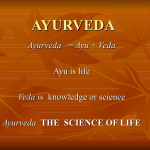
Article 1: Caring for Ourselves: Ayurveda
Peaceful and Happy Autumn with Ayurveda*
Ayurveda practitioner Heidi Nordlund shares Ayurvedic self-care practices, lifestyle tips and recipes for you to enjoy. … Read More

Article 2: Caring for Our Community: Soap-Making
Spotlight on the Handcrafted Arts Subcommittee
Erin Jay handcrafted this article about the TOC Handcrafted Arts Subcommittee and their recent success making soap… Read More

Article 3: Caring for Our World: Prachi Walk
Explore the mystery of the sacred Prachi Saraswati River in India and how an ancient prophecy connects her to you today.
Ages ago a powerful, sacred River Mother rushed eastward across the surface of India, tumbling and cascading in strong waves… Read More

Article 4: Face of Compassion: Saint Teresa, Mother of Compassion
What drives a person to be compassionate?
What compels someone to take action to make a significant difference in the lives of others? This issue’s “Face of Compassion” article features a look at the life of Agnes Bohaxhiu, who came to be known as Mother Teresa, who was sainted this month… Read More
Slideshow: Compassionate Quotes
[soliloquy id=”922″]
Back to Top
Article 1: Caring for Ourselves: Ayurveda
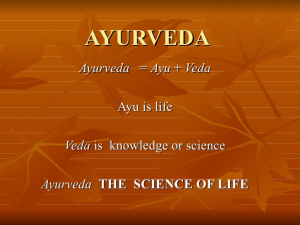 Peaceful and Happy Autumn with Ayurveda*
Peaceful and Happy Autumn with Ayurveda*
It is a great joy to share Ayurvedic home remedies, self-care practices, dietary and lifestyles tips, recipes, and various other recommendations related to women’s health in this quarterly Temple of Compassion newsletter.
I often think that Kriya Yoga is the answer to everything and as long as I practice daily with love, compassion and sincerity, no harm can happen to me. Reflecting on almost 17 years with Kriya Yoga, l can say that there is a lot of truth to this belief and I am deeply grateful to God and Gurus. At the same time, the practices of Ayurveda have made the path easier, understanding why certain imbalances occur, how to deal with them, and how to return to balance, well being and a place of compassion and love.
I hope you find these recommendations useful and inspiring and will incorporate some of them into your life so you can experience the benefits. The Divine Mother is within you and you have the power to change your life.
The seasons are changing and as without so within; the environment has a profound effect on your body and mind. The fall and spring seasons are times of change and transformation. You may have noticed that things get stirred up physically, mentally and emotionally this time of year and it is common to experience more imbalances. This is an ideal time and opportunity to rest your digestion and to rid your body from toxins. Here are a few suggestions:
Simple and Cleansing Lentil Soup (Dal)
Ingredients
- 1 cup split or whole mung beans, or red lentils
- 6-8 cups water
- 1″-2″ ginger, grated or blended with water
- 1 TBSP mustard seeds, soaked in hot water for 10-20 min. and blended with water
- 1 tsp turmeric
- 5 bay leaves
- 1 large handful leafy greens (kale, mustard, chard, collard or dandelion)
- 3-4 stalks celery
- Little oil for frying spices (ghee, coconut, sunflower)
- ½ tsp cumin seeds
- 1 tsp ground fenugreek
- Handful celery
- Fresh squeezed lime juice
- Lots of love and compassion
- Salt and black pepper to taste
Directions
- Soak lentils overnight or for at least a few hours
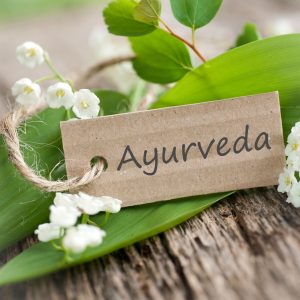
- Rinse the lentils well
- In a large pan, boil together lentils, turmeric, blended ginger and mustard seeds, bay leaves, leafy greens, celery and water. Alternatively, for a quick recipe, pressure-cook the lentils
- In a wok or frying pan, heat the oil. Turn the burner to warm and add the cumin seeds and fenugreek powder. Add to the cooked lentil mix. It will sizzle as you add it. Cook for ten minutes to let the flavors mingle.
- At the last minute, drop in the cilantro
- Add lime juice, salt and black pepper to taste.
Fast on this dal for 1-5 days and take plenty of water and rest.
Abhyanga (Ayurvedic Oil Application)
Massage your body with love and compassion for 15-30 minutes before you shower.
Warm about ¼ cup oil (sesame, coconut, almond, sunflower or an Ayurvedic herbal infused oil).
Apply the oil to the whole body and massage briskly in circular movements on your joints and up and down strokes on your long bones (fingers, arms, neck and legs).
Whole body massage can be done any day of the week, but ancient texts and common practice say that oil should only be massaged into the hair and scalp on Fridays for women, or on Saturdays for men. This works with a natural cycle of nature.
This massage done before you shower will allow the oil to deeply penetrate all layers of your skin, lubricate and loosen toxins.
Taking a warm or hot shower or bath afterwards will penetrate the oil further and allow for greater benefits such as toning your muscles, calming your nerves and leaving you with a feeling of being cared for.
Do not oil your body after the shower or bath!!! The oil or lotion/cream will then clog your pores leading to more toxins. Instead take the time to oil your body BEFORE you shower. Just try it, I bet that you will LOVE it! ?
Gandush (Ayurvedic Oil Pulling)
Another wonderful way to gently cleanse is oil pulling, this is an ancient Ayurvedic self-care practice. During oil pulling, enzymes are activated which draw toxins out of your blood. Oil pulling cleanses, detoxifies and whitens your teeth, reduces bacteria and plague, and relieves teeth sensitivity. Children can also do this with less quantity of oil provided they have control and practice not to swallow the oil.
Avoid if cuts are present in the mouth since infection can occur by germs through those cuts.
Directions
Oil pulling is best done first thing in the morning before brushing your teeth. To accelerate the healing process, it can be repeated three times a day, but always before meals on an empty stomach.
- Pour 1 tablespoon of sesame, sunflower or coconut oil into your mouth.
- Hold the oil in your mouth without swallowing it. The oil will start to get watery as saliva mixes with it. If there is an unbearable urge to swallow and if it becomes too unpleasant, spit out and try again. It can be a bit unpleasant at first, but soon not bothersome at all, just like brushing the teeth. When the oil has become saturated with the toxins it has pulled out, it may become whitish and a thinner, milky consistency, depending on the type of oil used. It can take a different amount of time to get to that point but 20 minutes is a general rule of thumb. If there are metallic substances in the mouth such as tooth fillings or implants, do oil pulling for only 5 minutes to prevent heavy metals from being reabsorbed into the body.
- Spit out the oil in the sink or trash can and rinse the mouth with warm salt water, or simply warm tap water, use your fingers to clean your mouth. Salt water is not necessary but is helpful as an antimicrobial and is proven to be effective in rinsing out toxins which may be left in the mouth.
- Then brush your teeth.
*Medical Disclaimer: The information provided in this article is not intended as a substitute for advice from your physician or other health care professional. Please consult with your physician before starting any diet, exercise or supplementation program, before taking any medication, or if you have or suspect you might have a health problem.
I’d love to hear from you. Please reply with a short comment about how you like the suggestions.
Wishing you a wonderful seasonal change. Remember to be compassionate and loving toward yourself. Jai Guru!
In Light, Love & Compassion,
 Heidi Nordlund
Heidi Nordlund
Health Practitioner & Spiritual Healer
720-771-8534 ׀ Heidi@NamaskarHealing.com
www.NamaskarHealing.com
www.LoveYourNewborn.com
Healing Your Body Is Your Choice ~ Make It Now!
HEIDI NORDLUND is on a mission to uplift those who are ready to walk the path of transformation and heal physically, emotionally and spiritually. Heidi is an Advanced Practitioner of Ayurveda with multiple degrees in Ayurvedic medicine. She has completed three certified Ayurvedic degrees: Advanced Ayurvedic Practitioner (Bhishakgwara) and Ayurvedic Practitioner (Ayurved Vaidya) from Alandi Ayurved Gurukula in Boulder, CO, as well as Ayurvedic Practitioner from the Rocky Mountain Institute for Yoga and Ayurveda. In addition, Heidi has completed advanced intensives in pulse reading, marma chikitsa, herbology and clinical assessment with Vasant Lad at the Ayurvedic Institute in Albuquerque, NM.
Article 2: Caring for Our Community: Soap-Making
Spotlight on the Handcrafted Arts Subcommittee
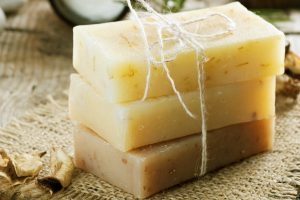 Such exciting times for the Temple of Compassion village as we work together to make Gurudev’s vision for this ashram a reality!
Such exciting times for the Temple of Compassion village as we work together to make Gurudev’s vision for this ashram a reality!
From the Fundraising Subcommittee to the Land Search Subcommittee everyone is coming up with ideas and adding their time and talents. It is a wonderful feeling to be a part of such noble work and to take part in such a golden opportunity.
The Handcrafted Arts Subcommittee has been busy too. It is said that the hands bring the heart into the world. Here is what Core Team Member Cheryl Dockery has to say about the committee, their projects, and how the work will bring more compassion into the world.
What is the Handcraft Subcommittee and what is its purpose in the greater Temple of Compassion picture?
The Handcrafted Arts subcommittee (initially dubbed Cottage Industries, which was confusing) is formed to organize participants to make products at their own location, or the Texas Ashram, to be sold in fundraising efforts for the Temple of Compassion.
What kind of projects do you have in the pipeline? (Short term and still further out)
Our initial project is handmade scented bar soaps, and our initial batch is currently in the curing stage.
Other projects in the future are in the idea stage and are only limited by our imaginations and talents. Some of the named ideas so far are shawls, scarves, saris, pillows, cards, pouch bags, jewelry, spices, teas, seeds, etc. Some products will be made by individuals, some made at the Texas Ashram, some will be ordered wholesale with our Temple of Compassion logo on them.
Items will be for sale at the Texas Ashram, possibly sold in local communities with high tourist count, and the soaps sold at the Miami Ashram. We aspire also to create an online store where all can shop, and handmade items can be shipped from the makers’ locations.
How does compassion play a role in the projects you choose?
As you can tell from some of the named items, they relate very much to our practice of meditation, self-care and healthy foods. Compassion is the attitude, outreach in other areas as well is the action.
Who makes up this subcommittee?
An Austin Kriyavan has been instrumental in many design ideas for a minimalist contemporary presentation and appropriate products. She also is the inspiration for the online sales aspect of this work.
 Each of the Core Team Members supervises several subcommittees and helps get it off the ground and running; so initially I have been active in Handmade Arts in that aspect. The same is for Sevamayee helping out on this subcommittee with its initial soap product. There are 7 people from across the nation who have specifically signed up for this committee, and it is now being organized enough to begin to include them. I expect there will be many more as it begins to take more formation.
Each of the Core Team Members supervises several subcommittees and helps get it off the ground and running; so initially I have been active in Handmade Arts in that aspect. The same is for Sevamayee helping out on this subcommittee with its initial soap product. There are 7 people from across the nation who have specifically signed up for this committee, and it is now being organized enough to begin to include them. I expect there will be many more as it begins to take more formation.
The Handmade Arts subcommittee is looking for a person to come forward who would like to spearhead the projects and organize the efforts under the supervision of the Core Team member. Also, suggestions for products and processes are much welcome. We are just now getting this subcommittee off the ground, and I think that there is probably no end to the creativity we are about to discover.
If anyone is interested in participating, or has some ideas, we’d love to work with you! You can sign up here https://templeofcompassion.org/get-involved/, or drop us a line.
What is the soap project? Is it only soap? Do you plan to expand to other products? If so, what?
At its current stage, it is soap. Our future ideas will come from those becoming familiar with our direction and share with us their ideas and talents. The soaps could evolve into liquid soap, lotions, facial products, beard oil (yes, we shall not forget the gents).
What was the inspiration for it?
Swami Sampurnananda (we have known her as Katharine Ma all these years) provided Sevamayee with a recipe and said we can sell the soaps at the Miami Ashram at Gurudev’s Birthday Celebration in May. So with that permission, we moved forward!
How can people purchase the soap and where will the proceeds go?
They will be sold at the Birthday of Gurudev Celebration at the Miami Ashram May 26-30, 2016. We will let you know after that if there are any left, and the plan for the next batch. There are 54 bars total. The proceeds will go to the Temple of Compassion.
What is your process? Ingredients?
 The saponification process mixes 100% food grade sodium hydroxide with water, then it is added to various oils in a heated process. We used combinations of olive, sunflower, castor, coconut, apricot oils and shea butter. We added tea tree essential oil for one set, Orange essential oil for another and combined Spearmint with Lemongrass for the third set. Once they set, they were cut into bars and cured in a dark, warm environment for 3-6 weeks. We are packaging them with unbleached cheesecloth wrap, tied with twine and a logo label including the ingredients.
The saponification process mixes 100% food grade sodium hydroxide with water, then it is added to various oils in a heated process. We used combinations of olive, sunflower, castor, coconut, apricot oils and shea butter. We added tea tree essential oil for one set, Orange essential oil for another and combined Spearmint with Lemongrass for the third set. Once they set, they were cut into bars and cured in a dark, warm environment for 3-6 weeks. We are packaging them with unbleached cheesecloth wrap, tied with twine and a logo label including the ingredients.
How is this process/project compassionate and/or raising your awareness of compassion?
Self-loving care is a compassionate action. Of course, you can also give as a gift!
Anything else you’d like to add about compassion, the soap project, or the subcommittee?
One of the visions many of us have is the community efforts in handmade arts, groups of loving people coming together for creating and organizing. In the communities outlying our Ashram we would like to see our products portray compassion in an effort to reflect who we are. This subcommittee will become a highly viable aspect of our Ashram, and we look forward to seeing it develop.
Our soaps are still curing so they are not wrapped at this time, but here is the inspiration for our packaging that came from an Austin Kriyavan:
We are the bubbles, make us the sea….
Back to Top
Article 3: Caring for Our World: Prachi Walk
Secrets of Saraswati
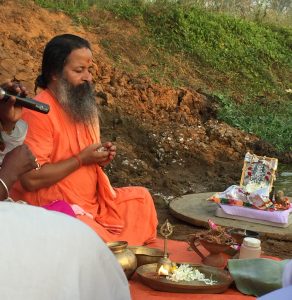 Ages ago a powerful, sacred River Mother rushed eastward across the surface of India, tumbling and cascading in strong waves until it reached the Bay of Bengal. She was called Prachi (or “East”) Saraswati and life thrived along her banks. Sage Kapila made his home near her shore.
Ages ago a powerful, sacred River Mother rushed eastward across the surface of India, tumbling and cascading in strong waves until it reached the Bay of Bengal. She was called Prachi (or “East”) Saraswati and life thrived along her banks. Sage Kapila made his home near her shore.However, the ancient Puranas not only spoke of the mysterious disappearance of Saraswati; they also foretold her return. And they prophesied that Saraswati would have assistance in making her reappearance. It said one day a monk will come and the river’s water flow will be restored to its full glory.
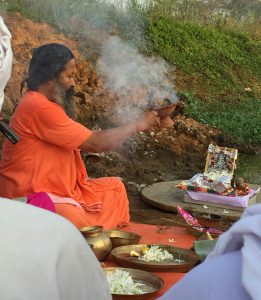 February 28 to March 5, 2016 marked the 5th year that Paramahamsa Prajnanananda and Kriyavans walked the path of the Prachi Saraswati River in Eastern India, from its source to the Bay of Bengal and back. Amazingly, since Guruji Prajnanananda has been walking the banks of Sri Saraswati, her water is increasing its flow!
February 28 to March 5, 2016 marked the 5th year that Paramahamsa Prajnanananda and Kriyavans walked the path of the Prachi Saraswati River in Eastern India, from its source to the Bay of Bengal and back. Amazingly, since Guruji Prajnanananda has been walking the banks of Sri Saraswati, her water is increasing its flow!
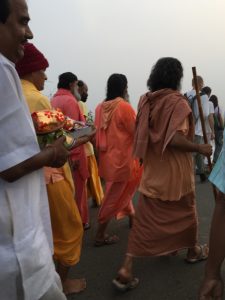 Paramahamsa Prajnanananda has a strategy for bringing back Mother Saraswati’s flow.
Paramahamsa Prajnanananda has a strategy for bringing back Mother Saraswati’s flow.
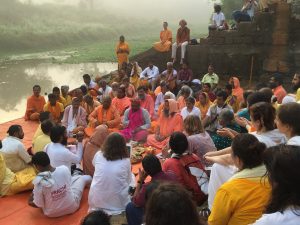 The lesson Baba is giving us about caring for Mother Nature and revering Mother Saraswati is far reaching. Not only is he showing the importance of respecting the environment, he is also breathing life back into this beautiful, ancient River Mother and the communities along her shores. His strategy of making the annual Prachi walks, raising local villager awareness, building community ghats and planting the right trees is the perfect plan.
The lesson Baba is giving us about caring for Mother Nature and revering Mother Saraswati is far reaching. Not only is he showing the importance of respecting the environment, he is also breathing life back into this beautiful, ancient River Mother and the communities along her shores. His strategy of making the annual Prachi walks, raising local villager awareness, building community ghats and planting the right trees is the perfect plan.
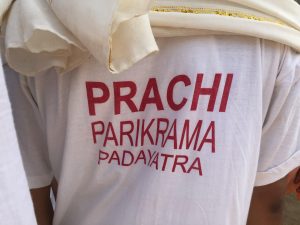 Guruji has helped us understand that, in literature, water often symbolizes divine love. Ghats are the steps that people use to enter into a river. And a monk comes along and plants trees which have deep roots that tap into the water and make the water gush. Perhaps the deeper meaning is that when divine love within us seems to have receded, this same monk, this Paramahamsa, is showing us the way to make divine love flow freely again. And the way to do this is to enter into the banks of the river of divine love and plant ourselves there, putting down deep roots through our saddhana and meditation. Then not only will the mysterious Prachi Saraswati happily flow again with divine love, but the torrent of divine love will flow freely in us, too.
Guruji has helped us understand that, in literature, water often symbolizes divine love. Ghats are the steps that people use to enter into a river. And a monk comes along and plants trees which have deep roots that tap into the water and make the water gush. Perhaps the deeper meaning is that when divine love within us seems to have receded, this same monk, this Paramahamsa, is showing us the way to make divine love flow freely again. And the way to do this is to enter into the banks of the river of divine love and plant ourselves there, putting down deep roots through our saddhana and meditation. Then not only will the mysterious Prachi Saraswati happily flow again with divine love, but the torrent of divine love will flow freely in us, too.Article 4: Face of Compassion: Saint Teresa, Mother of Compassion
What drives a person to be compassionate? What compels someone to take action to make a significant difference in the lives of others? This issue’s “Face of Compassion” article features a look at the life of Agnes Bohaxhiu, who came to be known as Mother Teresa, who was sainted this month.
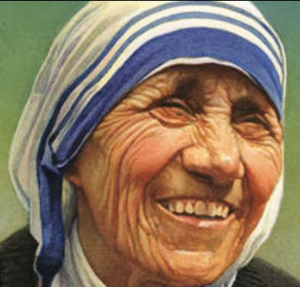 Little Agnes ran home from school, excited about hearing another spiritual adventure of missionaries who were traveling abroad. She rushed to her family’s map of the world, found the missionaries’ location on it and scrawled important notes there. Agnes was an ordinary child in Albania early in the 20th century but she had a special quality: she was powerfully inspired by stories of saints and missionaries.
Little Agnes ran home from school, excited about hearing another spiritual adventure of missionaries who were traveling abroad. She rushed to her family’s map of the world, found the missionaries’ location on it and scrawled important notes there. Agnes was an ordinary child in Albania early in the 20th century but she had a special quality: she was powerfully inspired by stories of saints and missionaries.
At the tender age of 12 she declared she wanted to be a missionary but her mother said she must wait until she was grown. At 19 years, Agnes made her dream a reality and joined a teaching order of Catholic nuns. She took the name Sister Teresa and was sent to India to teach, first in the Himalayan foothills in Darjeeling and then in Kolkata (Calcutta) at a high school for girls of wealthy families. Sister Teresa was very happy with her vocation but there was a longing growing inside her to help the poor. She was teaching the affluent but had a calling to help children whose families couldn’t afford schooling.
On the 10th day of September, 1946, the day she called, “Inspiration Day,” she heard God speak to her and ask her to start a new order of sisters to help the poorest of the poor. She heard the call again and again, “Wouldst thou not help?” With this calling burning inside her, she was compelled to action and got permission from the archbishop to start a new order. At first she was alone, the only missionary, educating impoverished children without a school building. She gathered children together and taught them basic hygiene, using sticks and dirt instead of pencils and paper. The students warmed quickly to her love for them and the classes grew in size. In time, she started visiting the children’s families. Some fortunate ones lived in ramshackle homes but many lived on the streets in the open air.
Sister Teresa later recalled that she would never forget the sight or smell of the first extremely sick and destitute person she took in. The woman lay dying on the street, bitten by rats and insects. Teresa, stirred with compassion, felt this woman’s pain and desperation of dying alone in this pitiable condition and she could not pass her by. She felt she must do something to help ease her suffering. Teresa lifted the woman and carried her to a hospital. At first the hospital employees refused to admit the dying woman but Teresa insisted they help her. The Sister of Charity would not leave until they admitted the woman and helped her. The hospital workers relented. And thus it began–Mother Teresa’s lifelong mission of helping the needy was firmly established in her heart.
She asked Kolkata city authorities for a place where she could care for people who were destitute and dying in the street. They gave this Catholic nun an empty building in a Hindu temple–and she filled it with patients in 24 hours! She gave people human dignity during their illness and death. Teresa’s former students came to help and some became the early Sisters of Charity. The work continued and Teresa taught the sisters to see the Divine’s presence in the face of each person. She quoted Jesus’ words from the cross, “I thirst,” and explained that God thirsts in the life of each needy person. The sisters saw it as an opportunity and responsibility to serve God in their fellow men and women.
Paramahamsa Hariharananda taught that service to our fellow man is service to God and Masters. There is no separation. A similar teaching is found in Jesus’ statement, “Whatsoever you do to the least of my brothers, that you do unto me.” How beautiful it is to see in Mother Teresa’s life such a compassionate example of this teaching in action.
In 1979 Mother Teresa was awarded the Nobel Peace Prize for her work and the work of her Sisters of Charity. She accepted the award on behalf of what she called “the throwaway society,” the forgotten poor, the “pavement people.” And she humbly requested that the celebratory, grand gala dinner be canceled and the money be given to the poor in Kolkata. India recognized her achievements and bestowed upon her the title of Bharat Ratna (Jewel of India). Her work in the streets of Kolkata became world famous and crossed all religious boundaries and she was praised not only by Catholics but also by Hindus, Jews, Muslims, Sikhs, Buddhists and others. Her ranks of missionaries has grown to more than 4500 Sisters and Brothers serving the needy in the slums of over 160 cities with hospitals, schools, hospice care and more. Mother Teresa left her body in 1997.
In 2011, Kriyavans from 35 countries around the world visited sacred sites in India on a pilgrimage honoring the 150th anniversary of Lahiri Mahasaya’s initiation into Kriya Yoga by Babaji Maharaj. Mother Teresa’s tomb was one of the holy sites they visited. Kriya pilgrims described the feeling of love and compassion they felt there as “tangible” and “profound.”
This month, the same month that we inaugurate the Temple of Compassion ashram, Mother Teresa was canonized by the Catholic Church and officially made a saint.
Let us bow to Saint Teresa in gratitude for her work with the destitute, a shining example of compassion in our world. Let us remember how she recognized the Divine’s presence in each person, how she felt their pain and took action to help them. Let us recall her teaching that God thirsts in others and know that we can reach out to help our brothers and sisters. Let us pray for more understanding, more love, more compassion and also for the strength and conviction to put that into action.
